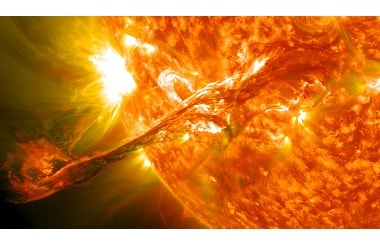
A group of researchers from Physical Research Laboratory (PRL), Ahmedabad, have, for the first time, figured out the conditions under which certain types of solar storms can flow towards the earth and affect its atmosphere.
This is important because such storms contain charged particles travelling at very high speeds and these can affect the electronics present on satellites in orbit around the earth.
Solar storms are violent events on the sun which can temporarily distort the earth's magnetosphere - the region around the earth which is influenced by its magnetic field.
These temporary disturbances, called geomagnetic storms, can generate shock waves in the interplanetary medium that can accelerate charged particles to very high energies and which, in turn, can harm the satellites placed by humans in space.
Such solar storms have two causes: Coronal Mass Ejections (CME) and Corotating Interaction Regions (CIR).
CME and CIR: Know More- CMEs are huge explosions of charged particles extending beyond the sun's corona or outer layer and can be visibly observed.
- CIRs are much more complicated and difficult to observe.
- CMEs can be detected by a coronagraph when they are ejected from the Sun
- CIRs are generated in the interplanetary medium and there are no visual signatures for CIRs. Hence, in order to detect [them], solar wind parameters need to be characterised critically
- Charged particles are being spewed continually out of the sun's corona, forming the solar wind. Some parts of these winds move faster than others.
- Since they contain charged particles in a plasma state, these different regions physically interact with each other to form wavelike disturbances called CIRs that emanate from the sun and spiral outwards.
- They are called "corotating" interaction regions as they rotate along with the sun, attached to it at one end.
- The sun goes through cyclic variations with a period of eleven years during which sunspot activity increases to a maximum and then decreases.
LI: Know More- There is an imaginary point on the line joining the sun and earth known as the L1 point or the Lagrange 1 point.
- A special feature of this point is that a particle placed there will feel no gravitational pull due to either the sun or the earth as the two forces cancel each other.
- CIRs that come at an angle of 6 degrees or less at the first Lagrangian point of the Sun-Earth system (L1 point) affect the earth's outer plasma environment.
- Those CIRs that are incident at angles more than 6 degrees at the L1 point will not reach the earth.
- This is the first time that such an understanding has been arrived at.
- The group plans to futher focus on the causes for the events when solar wind flow angle deviates from 6 degree for a considerable duration of time.